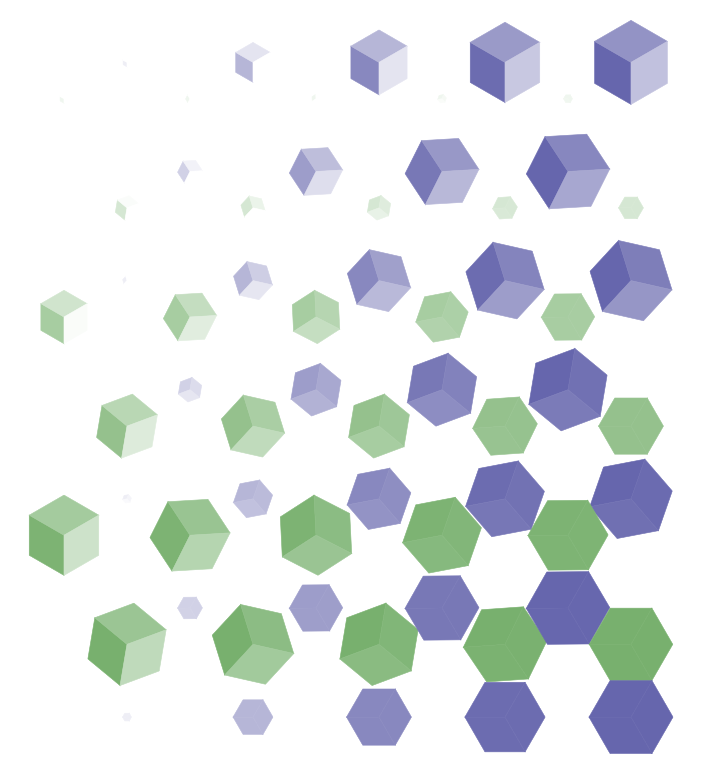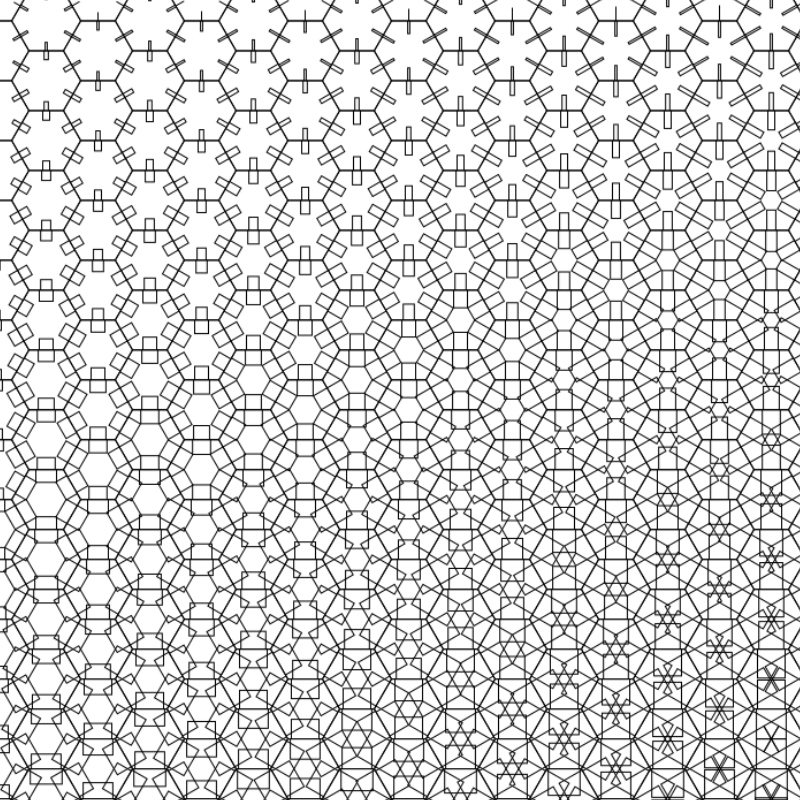Tesselation project (and a simple concave polygon hit test algorithm)
I’ve exhibited at Colony of Artists several times, a vibrant art festival at Abbeyhill Colonies in Edinburgh.
One of the things I was showing and selling was my tesselation pieces: designs inspired by MC Escher’s work, particularly matamorphosing tesselations.
Some of these pieces play with negative space and the transition from 3D to 2D:

Some have recomposition of objects:

Others play with simple rules that evolve designs:1

I made these images (and animations) with a python script I wrote. It outputs SVG and takes config from JSON files.
This tessselation engine is feeling a bit cranky and limited now, so I’m going to re-implement and improve it. And I’ve been thinking about implementing the tesselations in a GLSL shader for live animations.
… wobbly image, mysterious music, segue into hideous details…
Tesselated polygons in a GLSL shader
Yes, it’s probably silly, but I like the idea of having a tesselation engine in a single GLSL shader. None of your fancy vertex shaders here!
So the essential problem, for the colourful tesselation images, is detecting when a point is inside a polygon or not.
What kind of polygon?
Convex polygons (simple shapes, no bites taken out of them) are easy to implement in a shader – just check if a point is on a certain side of all the polygon edges.
Concave polygons (shapes with bites taken out) are not so straightforward. There’s some well known algorithms, such as Winding, for checking point+polygon hits.
But I’m wanting to keep it fairly simple. I’d like a simple-ish algorithm that:
- can handle some concavity, enough to do some kinds of tesselation
- stream based (scans a list of vertices, and in \(O(n)\) time) – no need for separate lists of ‘bite’ polygons/vertices
- uses only simple operations like isRightOf, no ray casting and dealing with edge case stuff
After some play in Swift2 with algorithms and shapes, I’ve found a fairly simple algorithm that handles a subset of concave polygons.
Concavex: a convex polygon with convex bites
Yeah, I made up a silly word. Please tell me if there’s an actual word for this!
A concavex is a concave polygon formed from a convex polygon minus convex bites at its edges (holes aren’t handled).
(pic coming!)
About the algorithm:
- runtime \(O(n)\)
- scans the list of vertices for the polygon stream-style, maintaining a few simple bits of state
- bails out early if it knows there can’t be a hit3
- does a pre-flight scan over the vertices to find an edge that turns right (as the starting point)4
I’ve implemented the algorithm in Swift and wrote unit tests for my sanity.
Here’s pseudo-code for the algorithm. It assumes vertices are given in clockwise order.5
// Inputs:
// vertices: points for the polygon (clockwise order!)
// point: coordinate to check for polygon inclusion
//
// Returns:
// true if point is in the polygon, otherwise false
let edges = vertices.makeEdges()
previousEdge = edges.last
// find first edge with RH turn at its start
start_edge_index = 0
while true {
let edge = edges[start_edge_index]
if edge.isToRight(previousEdge) {
break
}
previousEdge = edge
start_edge_index += 1
}
// streaming scan of edges
failOnNextRight = false
edge_index = start_edge_index
edges_scanned = 0
while edges_scanned <= vertices.count {
edges_scanned += 1
edge = edges[edge_index]
edgeIsToRightPrevEdge = edge.direction.isToRight(ofVector: previousEdge.direction)
if edgeIsToRightPrevEdge && failOnNextRight {
return false
}
pointIsToLeftEdge = (point - edge.start).isToLeft(ofVector: edge.direction)
failOnNextRight = pointIsToLeftEdge && (edgeIsToRightPrevEdge || failOnNextRight)
previousEdge = edge
edge_index = (edge_index + 1) % vertices.count
}
return true
The code above doesn’t look very complex. But it was pretty annoying to find the exact logic needed!
(More code to come)
check out Metamagical Themas by Douglas R. Hofstadter, there’s a lovely chapter on this sort of tesselation design ↩︎
the Swift code has unit tests. I’m not mad enough to try doing the research part in GLSL! ↩︎
early bail-out can happen on a right-turning edge, either because the point is to its left, or because we’ve just come out of a convex bite that didn’t have the point to the left of all its edges ↩︎
this is a far better alternative to making the alg work with the vertex list starting in the middle of a concave bite – I don’t think that would be worth the hassle/added complexity, after thinking on it. And obviously, if your data is well formed and you know you start on a right-turning edge, this pre-flight bit can be left out ↩︎
to handle CCW order, it should be enough to swap all the isLeft/isRight checks. Not sure off top of my head what would happen if you wrote
!isToLeftinstead ofisToRight. Edge cases are our doom ↩︎